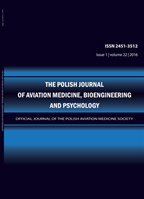2020, Volume 26, Issue 4
RELATIONSHIP OF THE NUTRITIONAL STATUS AND HANDGRIP STRENGTH IN MILITARY FLYING MEDICAL PERSONNEL
AGATA GAŹDZIŃSKA1, PAWEŁ JAGIELSKI2, MARTA TURCZYŃSKA1, JERZY BERTRANDT3, STEFAN P. GAŹDZIŃSKI4
-------------------------------------------------------------------------------------------------
1Laboratory of Dietetics and Obesity Treatment, Department of Psychophysiological Measurements and Human Factor Research, Military Institute of Aviation Medicine
2Department of Nutrition and Drug Research, Faculty of Health Science, Jagiellonian University, Medical College
3Faculty of Economic Sciences, John Paul II University of Applied Sciences in Biala Podlaska
4Creative Neuroscience Lab – CNS Lab, Military Institute of Aviation Medicine
Autor korenspondencyjny: AGATA GAŹDZIŃSKA; Laboratory of Dietetics and Obesity Treatment, Department of Psychophysiological Measurements and Human Factor Research, Military Institute of Aviation Medicine; email: afrotena@gmail.com
Full text
Streszczenie
Introduction: The aim of the study was to investigate the relationships between nutritional status and handgrip strength (HGS) of Polish military medical flying personnel.
Methods: The study was conducted among all active members of the personnel (71 males, 13 females) in Poland. Nutritional status was assessed by anthropometric and body composition measurements.
Results: Overweight was diagnosed in 47.6% and obesity in 11,9% members. Abdominal obesity was diagnosed in 38.6% of men and 23.1% of women. In women, the mean HGS of the right and the left hand, respectively, was 33.08 ± 3.57kg and 33.69 ± 2.95kg. For men, mean HGS of right and left hand were 55.79 ± 7.62kg and 54.63 ± 7.93kg, respectively. Furthermore, for men HGS was positively correlated with skeletal muscle mass (r = 0.39), lower limb length (r = 0.33) and chest circumference measured on inspiration (r = 0.33), but not on expiration. There was no significant correlation between HGS, age, and BMI.
Conclusions: Our study adds to the body of evidence demonstrating an alarmingly high proportion of soldiers with diagnosed obesity. Military medical flight personnel had higher mean handgrip strength as compared to reference values in the male group and in the female group in the left hand. Handgrip strength appears to be related to skeletal muscle mass, similarly to other studies in the general population.
Słowa kluczowe
obesity, overweight, nutritional status, fat mass index, handgrip strength, military flying medical personnel
